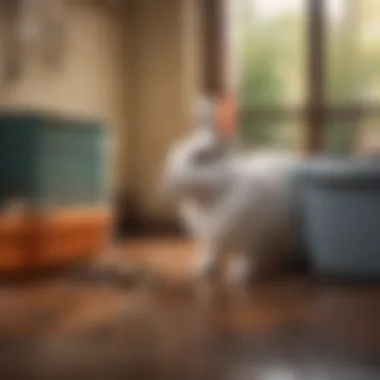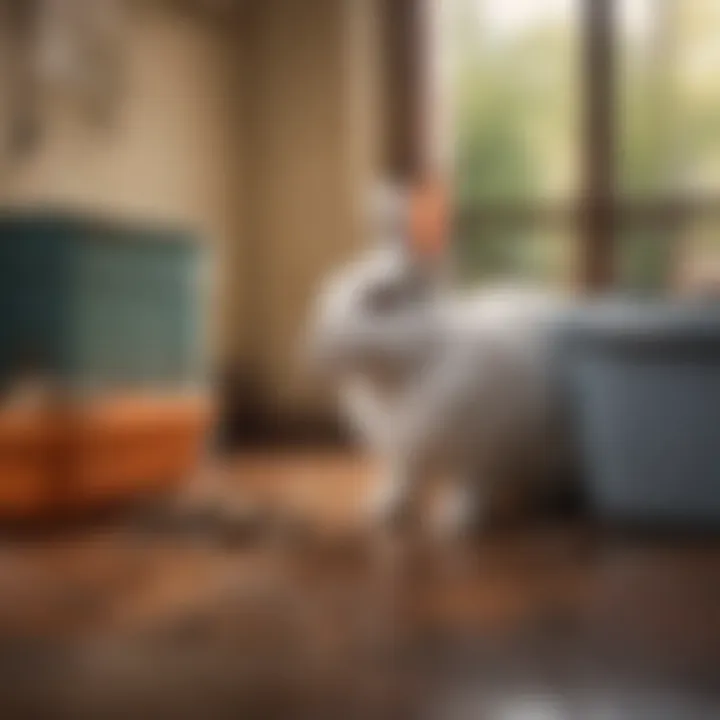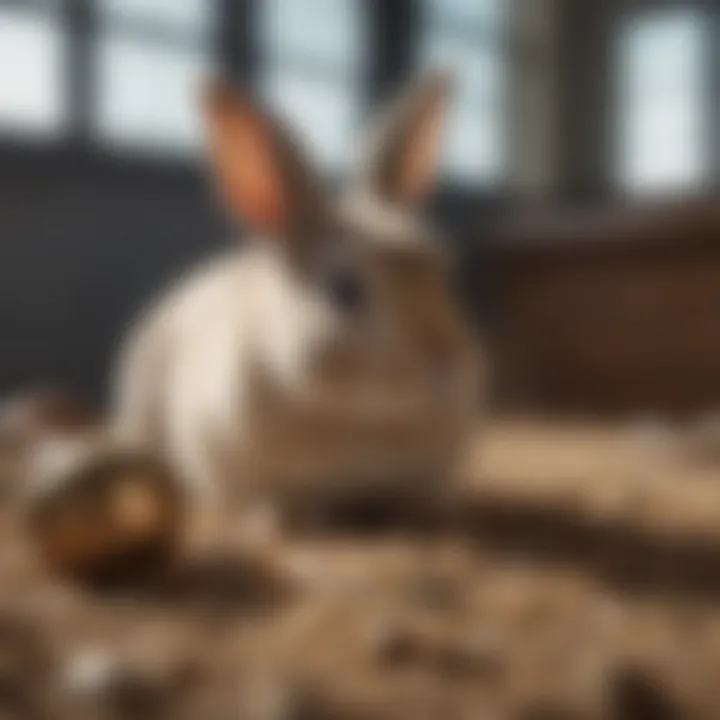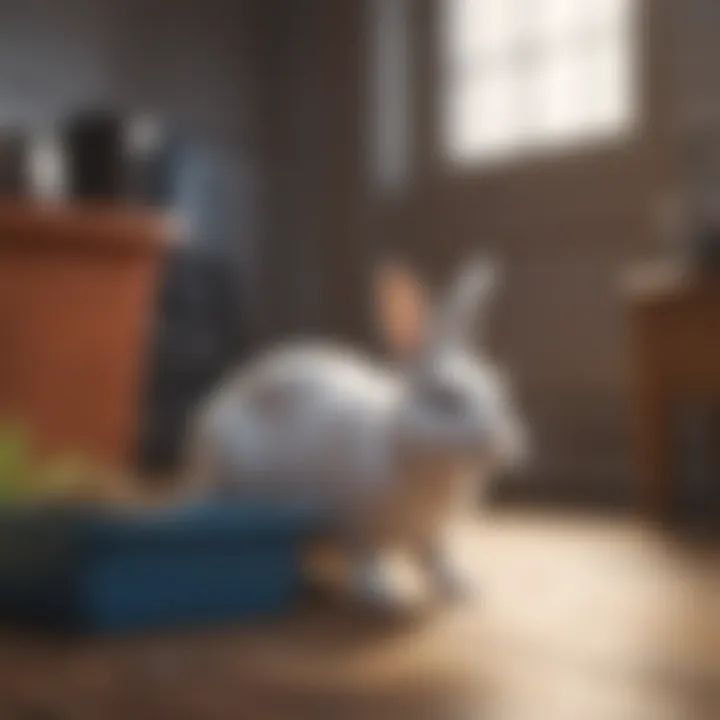Mastering the Art of Potty Training Your Rabbit


Intro
Potty training rabbits is not just about cleanliness. It touches on behavioral understanding and nurturing a bond with your pet. It can initially seem daunting, but with the right guidance, it becomes a manageable task. This guide explores effective techniques to encourage your rabbits to use specific areas for their bathroom needs. A harmonious living environment benefits both rabbits and their owners, making it essential to approach this topic methodically.
Care Tips
Daily Care Routines
Establishing a daily care routine is crucial for both you and your rabbit's comfort. Feeding times should be consistent, and regular handling helps in acclimating the rabbit to human presence. Spending time with your rabbit each day fosters trust. Use this time to observe behavior. If you notice signs of restlessness or other unusual behaviors, it may indicate a need for a bathroom break.
Cage Setup and Maintenance
An appropriate cage setup significantly impacts potty training success. Choose a space that is large enough for your rabbit to hop around, yet cozy enough for them to feel secure.
Ensure the cage includes:
- A designated litter area to encourage consistency.
- A comfortable sleeping area with soft bedding.
- Access to fresh water and food.
Maintaining cleanliness is important. Regularly clean the mess from the designated area to promote continued use.
Hygiene and Cleaning Practices
Routine cleaning of your rabbit's living space is essential. This includes:
- Removing soiled litter daily.
- Washing the litter box regularly with pet-safe cleaners.
- Ensuring the rest of the living area is free from old food and waste.
Enforcing good hygiene practices helps to prevent unwanted odors and maintains a safe space for your pet.
Seasonal Care Adjustments
Rabbits may need different care depending on the season. In winter, ensure the living area is warm enough. Offer additional bedding for insulation. During summer, provide shade and keep the area cool. Monitor your rabbit for signs of stress related to temperature changes. Adjust routines and environments as necessary.
Behavioral Insights
Understanding Rabbit Body Language
Rabbits communicate through body language, which is essential for understanding their needs. Look for:
- Ears held upright indicating alertness.
- A relaxed posture showing comfort.
- Thumping feet signaling distress or unease.
Recognizing these signals will enhance your ability to respond to your pet's needs effectively.
Common Behavioral Issues and Solutions
Some rabbits may resist using a litter box due to anxiety or territorial habits. Here are some solutions:
- Gradual introduction: Place the litter box in their preferred area.
- Multiple boxes: Offer various boxes in different spots until the rabbit chooses one.
Positive Reinforcement Techniques
Utilizing positive reinforcement is key in potty training. Each time your rabbit uses the litter area correctly, offer a small treat or gentle praise. This encourages them to repeat the behavior.
Social Interaction Needs
Rabbits are social creatures and can benefit from interaction with humans and other pets. Provide opportunities for them to explore, hop around, and engage with their environment. Social behavior plays a role in how they respond to training.
Nutrition Guides
Essential Diet Components
A balanced diet is vital for your rabbit's overall health. Include hay, fresh vegetables, and pellets. Ensure they have access to clean water at all times. A good diet aids in maintaining healthy bowel movements, which supports potty training efforts.
Safe and Toxic Foods
Be cautious with food choices. Some foods, like iceberg lettuce and chocolate, are harmful. Always research before offering new treats. Safe foods include:
- Carrots (in moderation)
- Spinach
- Bell peppers
Supplements and Treats
Consider providing supplements when necessary. These can enhance health, especially if your rabbit is picky about food. Natural treats, such as dried herbs, can be helpful as training incentives.
Feeding Strategies for Different Species
Each rabbit may require specific dietary adjustments. Pay attention to your rabbit's age, size, and activity level. For younger rabbits, a more nutrient-dense diet may be needed, while older rabbits may require lighter options.
Wellness and Health
Routine Health Checkups
Schedule regular checkups with a veterinarian experienced in rabbit care. This ensures you catch any health problems early and maintain your rabbit's overall wellness.
Identifying Symptoms of Illness
Keep an eye out for changes in behavior, eating habits, or litter habits. Unusual lethargy or changes in litter box use can indicate health issues. Quick action can prevent further complications.
Preventative Care and Vaccinations
Consult your veterinarian about necessary vaccinations. Preventative care becomes a critical part of managing your rabbit's health, ensuring they live a long, happy life.
Mental and Emotional Well-being
A rabbit's emotional health is as crucial as its physical health. Provide plenty of enrichment activities to reduce stress. Comfortable living spaces lead to happier and healthier rabbits.
Enriching Activities
Toys and Playtime Ideas
Engage your rabbit with a variety of toys. Chew toys, tunnels, and foraging items will stimulate their minds. Provide daily playtime outside the cage to keep them active and interested.
Training and Tricks


Potty training can integrate into a broader training regimen. Encouraging your rabbit to learn tricks can make the process enjoyable for both of you. Focus on simple commands initially and gradually build complexity.
Outdoor Activities and Interaction
Supervised outdoor time can be beneficial. It allows your rabbit to explore natural environments while you maintain control. Always use a harness or enclosed space to ensure safety.
DIY Projects for Mental Stimulation
Consider creating DIY toys or puzzles for your rabbit. This not only saves money but also allows for creativity. Simple items, like cardboard boxes or paper towel rolls, can provide hours of entertainment.
Potty training is not a one-time effort; it requires patience and consistency for the best results.
Prelude to Potty Training Rabbits
Potty training rabbits is a crucial step in fostering a harmonious environment for both the pet and its owner. While rabbits are often misunderstood, they have distinct habits and preferences that can be effectively channeled into training routines. Understanding these behaviors lays the foundation for a successful potty training experience.
Understanding the Importance of Litter Training
Litter training is vital for several reasons. First, it helps maintain hygiene in the living space of both the pet and the owner. Rabbits are naturally inclined to choose specific areas to relieve themselves, so understanding this instinct allows for more effective training. By designating a litter area, owners can minimize mess and odors, creating a more pleasant environment. Additionally, rabbits thrive in clean surroundings, which can lead to overall healthier living.
Another key reason for focusing on litter training is behavioral enrichment. Rabbits are intelligent animals, and they benefit from mental stimulation. Training them to use a litter box engages their natural instincts and offers them a sense of purpose. Moreover, it encourages bonding between the pet and the owner; when a rabbit learns to use a designated litter area, it often forms a deeper connection with its caretaker.
Benefits of a Potty Trained Rabbit
A potty trained rabbit can bring numerous benefits to its owner. Firstly, having a rabbit that consistently uses a litter box simplifies the cleaning process. It reduces the time and effort spent on cleaning accidents around the house. Owners can focus more on enjoying their pet’s company rather than dealing with mess.
- Improved Hygiene: A litter-trained rabbit minimizes the risk of urine and feces spreading across living areas.
- Enhanced Behavior: When a rabbit understands where it should relieve itself, it often feels more secure and settled in its environment, which can lead to improved overall behavior.
- Convenience for Owners: A designated bathroom area means that pet owners can provide the necessary upkeep with less hassle.
- Encouraged Freedom: A well-trained rabbit can have more freedom within the house. Making it easier for owners to have their pets out without constant supervision.
By investing time in potty training, owners not only enhance their living space but also contribute to the overall well-being of their rabbit. As such, understanding the dynamics of litter training can significantly impact the shared life between the rabbit and its owner.
Rabbit Behavior and Biology
Understanding rabbit behavior and biology is crucial for anyone embarking on the journey of potty training their pet. The success of litter training largely depends on how well an owner grasps the natural tendencies of rabbits and their physical health. By recognizing these factors, one can create a conducive environment for training and minimize frustrations that may arise during the process.
Natural Instincts of Rabbits
Rabbits are prey animals with certain innate behaviors that shape their instincts. One significant instinct is their inclination to establish a specific area for their bathroom needs. This behavior stems from their desire to keep their living spaces clean and reduce odor, which is instinctual for evading predators.
In the wild, rabbits often choose a designated spot, known as a "latrine," where they consistently relieve themselves. This natural tendency can be harnessed and encouraged during the training process. Therefore, understanding this instinct can help owners identify where to place litter boxes and attract the rabbit to that area.
Additionally, rabbits are creatures of habit. They thrive on routine in their daily lives, which extends to their bathroom behavior. Establishing a consistent schedule for food and exercise can enhance the effectiveness of litter training. This will aid in making them feel secure and more inclined to use the designated bathroom area.
How Digestive Health Affects Training
The training process cannot be fully effective without considering a rabbit's digestive health. Rabbits have a unique digestive system that requires special attention. Their diet, primarily composed of hay, fresh vegetables, and a limited amount of pellets, plays a significant role in how often they relieve themselves.
Rabbits produce two types of droppings: hard fecal pellets and softer cecotropes. The regularity of their droppings affects training success significantly. A well-balanced diet ensures consistent bowel movements, allowing training to proceed more predictably.
It is also crucial for pet owners to note any changes in their rabbit's elimination patterns. Irregularities can indicate health issues, such as digestive upset or illness. Owners should be observant and proactive in addressing such changes with a veterinarian if necessary.
Overall, understanding both the instinctual behaviors and the biological needs of rabbits provides a solid framework for successful potty training. By aligning training strategies with these factors, owners can create an environment that respects the rabbit's nature while teaching appropriate bathroom habits.
Selecting the Right Materials for Training
In potty training rabbits, selecting the right materials can significantly impact the success of the process. Not only does it create a comfortable and appealing environment for the rabbit, but it also ensures that the owners are ultimately satisfied with the setup. Choosing the right litter material and litter box can help minimize mess and odors. It also plays a crucial role in encouraging rabbits to use their designated areas consistently. Therefore, it is necessary to give careful thought to both of these aspects.
Choosing a Litter Material
Choosing a suitable litter material is vital as it affects the rabbit's comfort and willingness to use the litter box. The right litter can provide a familiar texture that they like, making the training process smoother.
Wood Pellets
Wood pellets are a popular choice among rabbit owners. They are made from compressed sawdust and have a significant ability to absorb moisture. This feature allows them to control odors effectively.
The key characteristic of wood pellets is their eco-friendliness. They are often made from recycled materials, which appeals to environmentally conscious owners. A unique feature of these pellets is that they expand when wet, forming sawdust that absorbs waste, thus retaining their efficiency.
Advantages:
- Highly absorbent, reduces odors well.
- Eco-friendly and made from recycled wood.
Disadvantages:
- Some rabbits may not prefer the texture initially.
- They can be a bit messier during cleaning, as the sawdust can scatter.
Paper-Based Litters
Paper-based litters come from recycled paper, making them a sustainable option. Their soft texture can be kinder on a rabbit's paws compared to many other materials. Thus, it offers a pleasant experience for the rabbit, encouraging them to use the box.
The key characteristic of paper-based litters is their low dust content, which can help reduce respiratory issues for both rabbits and their owners. A unique aspect of these litters is that they can absorb liquid effectively while providing a softer surface.
Advantages:
- Soft texture is comfortable for rabbits.
- Low dust particles, safer for respiratory health.
Disadvantages:
- May not control odors as well as some other materials.
- Can become soggy and require more frequent changes.
Care Fresh Alternatives
Care Fresh is a popular brand of litter made of natural paper fibers, and it is marketed as being particularly absorbent. This choice is good for those who want a product explicitly designed for small animals.
A significant advantage of Care Fresh alternatives is their capacity to minimize odors due to their absorbent properties. The unique feature of these materials is that they are highly biodegradable, offering an environmentally conscious solution for rabbit owners.
Advantages:
- Great odor control due to strong absorbency.
- Biodegradable and environmentally friendly.
Disadvantages:
- Often more expensive than traditional litters.
- Some rabbits may not accept it immediately.


Ideal Litter Box Options
Choosing the right litter box is as important as the litter itself. The right box can encourage consistent use. Factors like size, design, and placement all play roles in ensuring effective potty training.
Size Considerations
When it comes to size, a litter box should be spacious enough for the rabbit to move around comfortably. A box that is too small can lead to accidents. Rabbits tend to back away when they feel confined. The key characteristic is that the box needs to allow the rabbit to turn around and enter without feeling restricted.
Advantages:
- A larger box can serve multiple rabbits effectively.
- Reduces chances of accidents due to space constraints.
Disadvantages:
- A larger litter box can take up more room.
- May require more litter, increasing cost.
Design Variations
The design of the litter box can affect a rabbit's willingness to use it. Some boxes come with high sides to prevent litter from being kicked out, while others may have lower entries for easy access. The key characteristic of these designs is that they can meet various rabbit needs.
Advantages:
- Variations can cater to unique behavioral traits in rabbits.
- High-sided boxes can contain more litter and mess.
Disadvantages:
- Some designs may be difficult for older or disabled rabbits to use.
- Aesthetics may not fit well in every home.
Placement Tips
Where the litter box is placed can significantly influence a rabbit's litter training success. A quiet, low-traffic area is ideal for placement; this ensures the rabbit feels safe while using it. The key characteristic of proper placement is that it should be easily accessible to the rabbit at all times.
Advantages:
- Encourages consistent use by making the box easily reachable.
- Helps minimize stress during bathroom time.
Disadvantages:
- Finding the right spot may take time and experimentation.
- Owners might need to rearrange other items to ensure placement is ideal.
The combination of choosing appropriate litter and litter boxes is essential for successful potty training. It acts as the foundation upon which a consistent habit can be built.
Creating the Training Environment
Creating a proper training environment is crucial for the successful potty training of rabbits. The training space needs to be conducive to learning, promoting comfort and predictability for the rabbit. By setting up an environment tailored to their instincts and behaviors, pet owners increase the chance of success in this endeavor. Here, we discuss two essential aspects: establishing a designated bathroom area and maintaining a clean space.
Designated Bathroom Area
A designated bathroom area functions as the foundation of effective potty training for rabbits. It is essential that this area is easily accessible and clearly identifiable. Rabbits are creatures of habit, and they tend to establish their own spots for toileting.
When selecting a location, consider the following:
- Quiet and Private: Choose a spot that is away from noise and high traffic. This encourages the rabbit to feel secure.
- Consistent Placement: This area should remain fixed in its location. Moving the bathroom area can confuse the rabbit and hinder the training process.
- Comfortable Space: Ensure that the space is free of distractions. The litter box should invite your rabbit to use it without hesitation.
Making the designated area attractive is helpful as well. You might use a specific type of litter that your rabbit seems to prefer. Observe their habits closely. This observation is key to understanding where they feel comfortable eliminating waste.
Maintaining a Clean Space
The cleanliness of the environment plays a significant role in litter training success. Rabbits are naturally inclined to avoid soiled areas. Maintaining a clean space can enhance this instinct, reinforcing the behavior you want them to adopt.
Consider these points for upkeep:
- Regular Cleaning: Remove waste promptly. It helps to keep the designated area appealing for your rabbit. A clean environment also prevents smell and promotes hygiene.
- Monitor for Accidents: Pay attention to any signs of where the rabbit may have eliminated outside the designated area. This information can help track their habits and identify areas needing reinforcement or adjustment.
- Health and Safety: Use non-toxic cleaning agents when necessary. Strong smells can repel a rabbit, making them less inclined to use their litter box.
"A clean environment leads to better behavior, creating a correspondence between what is habitable and what is not."
In summary, establishing a designated bathroom area and maintaining cleanliness are fundamental to creating an effective training environment for your rabbit. Both elements contribute to the overall success of potty training, fostering a sense of security and obedience that every pet owner desires.
The Training Process
The training process is a central aspect of potty training rabbits, directly influencing the success of creating a clean living environment. Establishing effective routines and recognizing signs of behavior are critical components. Developing a systematic approach helps the owner guide their rabbits towards acceptable bathroom habits while fostering a strong bond through understanding and communication.
Establishing a Routine
Establishing a routine is foundational to effective potty training. Just like any animal, rabbits thrive on predictability. A well-defined daily schedule helps rabbits learn when and where to relieve themselves. Aim for consistent feeding times, as this correlates with their digestive patterns. A common strategy is to allow the rabbit to eat at the same time each day, which promotes regular bathroom habits. After meals, take your rabbit to their designated bathroom area. This not only provides them an opportunity to empty their bladder but also reinforces the connection between feeding and using the litter box.
Additional elements of the routine should include regular playtime sessions. Between these sessions, it is essential to monitor and guide the rabbit back to its designated area. By linking bathroom visits with play, rabbits start to grasp the importance of their designated space, which will lead to a smoother potty training process.
Observing and Responding to Signs
Observing and responding to behavioral signs plays a crucial role in monitoring and guiding your rabbit's potty training journey. Rabbits are often subtle in their communications, so it’s vital to be attentive to their behaviors.
Pre-Training Signals
Pre-training signals can include a variety of specific behaviors that indicate when the rabbit is about to relieve itself. Common signs include sniffing the ground, circling a specific area, or squatting. Recognizing these signals allows owners to anticipate their rabbit's needs effectively. These signals represent a key characteristic of successful training cycles. Owners who understand these prompts can intervene before an accident occurs, directing the rabbit toward the right location. However, every rabbit is distinct, and there may be a learning curve involved in recognizing their individual cues.
Post-Training Behavior
Post-training behavior is critical for understanding how effective training has been. After successfully using the litter box, rabbits may exhibit signs of satisfaction, such as grooming or relaxing. This behavior reinforces the positive aspects of litter training, helping owners gauge their progress. A key characteristic of this phase is the change in the rabbit's demeanor; a confident and relaxed rabbit is often a sign of successful potty training.
This progress may also include some slip-ups or accidents, which should be considered normal parts of the process. A rabbit that uses the litter box consistently often displays enthusiasm for returning to this area. Monitoring these behaviors allows owners to assess ongoing effectiveness of their training strategies and make adjustments as necessary.
Positive Reinforcement Techniques
Positive reinforcement is a central approach in the training process. This technique emphasizes rewarding desired behaviors rather than punishing mistakes. Rewards can range from treats to affection. This method encourages rabbits to associate the litter box with positive outcomes. Regularly acknowledging successful usage will help solidify the habit. Also, timing is key; rewards should be given immediately after the desired action to ensure that the rabbit associates its behavior with the reward clearly.
Observing and responding to behaviors while establishing a consistent routine and using positive reinforcement collectively create a roadmap for success in potty training. By applying these strategies diligently, owners can greatly enhance the training process and their rabbit’s comfort in using designated areas.
Common Challenges and Solutions
Potty training rabbits can often present challenges, even in the best of circumstances. Addressing these challenges is crucial to ensure a smooth training process and to foster a positive environment for both rabbit and owner. Understanding common difficulties can help owners prepare better and respond effectively. Recognizing these potential issues allows owners to implement necessary strategies, leading to successful litter training.


Addressing Accidents
Accidents are a normal part of the potty training process. Even well-trained rabbits may have occasional mishaps. It is essential to handle these incidents without frustration. Instead, focus on learning from the situation. Here are some points to consider:
- Identify Triggers: Determine if specific situations lead to accidents. Changes in diet, stress, or new environments can affect behavior.
- Cleaning Products: Use appropriate cleaning supplies that eliminate odors. This helps prevent the rabbit from returning to the same spot.
- Reinforce Training: After an accident, revisit training practices. Ensure the litter box is appealing. Consider the placement of the box and accessibility.
Responding calmly to these accidents is key. Punishment is not effective and may create fear.
Dealing with Refusal to Use the Litter Box
Some rabbits may refuse the litter box altogether. This behavior can be frustrating for new owners. Understanding the reasons behind this refusal is important. Here are some factors to consider:
- Box Size and Type: Ensure the litter box is the right size for your rabbit. Small boxes may discourage use. Experiment with different styles to find what your rabbit prefers.
- Stress and Anxiety: Changes in the environment can result in reluctance to use the litter box. If there have been recent changes, address them to create a sense of security.
- Health Issues: Sometimes, refusal may indicate underlying health problems. If this persists, consult a veterinarian. Medical concerns should never be overlooked.
The Role of Owner Consistency
Owner consistency is a cornerstone of successfully potty training your rabbit. In many ways, rabbits are creatures of habit. They thrive on routine, and they need clear guidelines to establish good behaviors. When owners maintain a steady approach, rabbits can adapt more easily. Inconsistent practices can lead to confusion for the rabbit, lengthening the training period and complicating the process.
Consistency in Training Sessions
Creating a regular training schedule is essential. These sessions should ideally occur at the same time each day. Regularity helps the rabbit recognize the training as part of their daily routine. Furthermore, keep the sessions short but focused. Too much time spent on training may overwhelm your rabbit. A good duration is about 10 to 15 minutes.
During these sessions, reinforce the behaviors you want to see, such as using the litter box. Praise your rabbit immediately after they use it correctly. This positive reinforcement is a powerful motivator. It becomes even more effective if you use the same treats each time. By providing them consistently, your rabbit will link the behavior with the reward.
Benefits of Consistency in Training
- Improved Understanding: Rabbits learn through repetition. Consistent training helps them understand expectations.
- Reduced Anxiety: A stable routine lowers the chance of anxiety in rabbits. They know what to expect, which is reassuring.
- Faster Learning: Consistency can lead to quicker mastery of litter habits, shortening the overall training period.
By sticking to a consistent training regimen, owners help their rabbits adjust and embrace new behaviors, which can create a more harmonious home environment.
Communicating Expectations to Family Members
Once the owner establishes a training routine, it is crucial to ensure that all family members are on the same page. Everyone involved in the rabbit’s care should clearly understand the goals of potty training and their role in maintaining consistency. Inconsistent messages can confuse the rabbit, which can hinder training progress.
Family meetings might help in discussing how to interact with the rabbit during training. It is essential to explain to children and other adults that they should not scold the rabbit for accidents but instead follow the owner's cues. Setting clear guidelines helps everyone know what is expected.
Strategies for Effective Communication
- Create simple rules for your rabbit’s care. Write them down if needed, so they are easy to remember.
- Share the same positive reinforcement methods with all family members. This unity promotes reliable training outcomes.
- Encourage open discussions about any challenges faced during training. This can foster a supportive environment for the rabbit.
The success of litter training is not purely in the hands of the primary caretaker. With a coordinated effort among all family members, the rabbit can achieve a smoother and more effective transition into their potty trained routine.
Monitoring Progress
Monitoring progress is a critical phase in potty training rabbits. This step is about observing how well your rabbit is adapting to the litter training process. Consistent tracking can help you determine which methods are most effective and when adjustments might be necessary.
Following the training plan requires vigilance. By monitoring your rabbit’s behavior closely, you can identify key changes in habits, preferences, or responses to the training environment. These insights are invaluable and can make the difference between success and frustration.
A major benefit of monitoring progress is that it empowers the owner. When you recognize a pattern in your rabbit's behavior, you can effectively troubleshoot and adapt your strategies. This ongoing assessment plays a significant role in achieving a clean and well-behaved household.
Keeping Track of Behavioral Changes
Regularly noting behavioral changes of your rabbit aids in understanding their learning curve. Start by maintaining a journal or a chart to quickly note down each time they use the litter box successfully or have an accident outside the designated area.
Key aspects to consider include:
- Frequency of Successful Uses: Track how often your rabbit goes in the litter box versus elsewhere. This will help gauge improvement over time.
- Consistent Patterns: Look for any patterns in timing or location of bathroom habits. Such data can reveal preferences that may influence litter box placement.
- Reactions to Reinforcement: Pay attention to how your rabbit reacts to rewards or positive reinforcement. Are they becoming more responsive?
Analyzing this data will help you see trends and anticipate any potential setbacks.
Adjusting Strategies When Necessary
As you monitor your rabbit’s potty training journey, you may discover that some strategies need to be adjusted. This flexibility is essential for long-term success. Here are considerations for when adjustments are needed:
- Evaluate Litter Material: If your rabbit consistently avoids the litter box, consider whether they dislike the litter material. Switching to another type or brand could encourage better behavior.
- Litter Box Location: If your rabbit seems hesitant, assess the placement of the litter box. Ensure it is in a quiet and easily accessible location.
- Routine Modifications: If accidents become more frequent, revisit the established routine. Sometimes, returning to a simpler training process temporarily can reinforce positive habits.
“Adapting strategies based on your observations is key. Remember, each rabbit is unique and may respond differently.”
Long-Term Maintenance of Litter Training
Long-term maintenance of litter training is a crucial aspect of ensuring continued success in potty training your rabbit. After initial training is completed, many owners may assume that the job is done. However, maintaining established habits requires ongoing attention, as rabbits are creatures of habit with behaviors that can change over time. This section will address the need for reinforcement and monitoring to ensure your rabbit retains its training.
The significance of reinforcing established behavior cannot be overstated. Long-term success in potty training hinges on consistent reinforcement of the expected behavior. Just as with any training, positive feedback is essential. Regularly offering treats or praise when your rabbit uses the litter box reinforces that action. This approach encourages your rabbit to continue utilizing the appropriate areas for bathroom needs and fosters a positive relationship between you.
Reinforcing Good Behavior
To maintain litter training effectively, reinforcing good behavior must become a routine part of your interaction with your rabbit. Here are some important things to consider:
- Consistency is Key: Always reward your rabbit for using the litter box. Make it a habit to praise and treat immediately after they do so. This immediate feedback lets them know they have performed the desired behavior correctly.
- Routine Maintenance: Regular cleaning of the litter box not only ensures hygiene but also signals to your rabbit that this area is important. If the litter box is dirty, your rabbit may choose to avoid it.
- Placement of Treats: Occasionally placing treats around the litter box during training can promote usage. This tactic draws their attention to the box and associates it with positive outcomes.
- Monitoring Changes: As your rabbit ages or as environmental factors change, be observant. Changes in routine or household may affect their behavior. Adjust your reinforcement methods if needed.
"Consistency in reinforcement nurtures an environment where rabbits feel secure and confident in their training."
Correcting Relapses in Behavior
Despite your best efforts, there may be times when your rabbit may regress or show reluctance to use the litter box. It is essential to address these relapses promptly to prevent the establishment of undesirable habits. Here are some strategies to consider:
- Identify Triggers: Understand the factors contributing to the change in behavior. Stress from environmental alterations, such as new pets or changes in household routine, could play a role. Recognizing these triggers will allow you to address them effectively.
- Reiterate Training: If relapses occur, revisit basic training steps. Spend some time reinforcing the litter box association. This may involve supervised time spent near the box, rewarding for correct usage, or even using paper towels from the litter box to help remind the rabbit where to go.
- Consult a Vet: Should a sudden change in behavior occur, it is wise to consult a veterinarian. Health issues can sometimes cause changes in bathroom habits, and it’s important to rule out any medical concerns.
- Patience and Persistence: Remember to be patient. Corrections may take time. Rely on positive methods rather than punishing behavior. A supportive approach fosters better long-term results.
Maintaining litter training requires dedication. With repeated reinforcement and attention to changing behaviors, your rabbit can remain a well-trained companion.
Closure
The conclusion of this article highlights the significance of effectively potty training rabbits for both pet owners and their furry companions. Understanding rabbit behavior, consistency, and positive reinforcement techniques create a solid foundation for successful potty training. It is important to recognize that litter training not only maintains cleanliness within the home but also contributes positively to the rabbit's overall well-being. A trained rabbit is likely to exhibit more relaxed behavior, reducing stress for both the animal and the owner.
Summary of Effective Potty Training Techniques
When considering effective potty training methods, several key techniques become apparent. Here are some important takeaways for pet owners:
- Establish a Routine: Setting specific times for litter box access can reinforce habits. Rabbits thrive on consistency.
- Positive Reinforcement: Using treats or gentle praise can motivate rabbits to use their designated bathroom area.
- Monitor Signs of Need: Understanding your rabbit's behavior, such as circling or sniffing, can help in anticipating bathroom needs.
- Use Appropriate Litter Box and Materials: Ensuring the litter box is suitable for the size of your rabbit will encourage its use. Materials like paper-based litter can be effective and safe.
Incorporating these techniques can facilitate a smoother training process and create a conducive environment for your rabbit.
Encouraging a Lifelong Habit
Encouraging a lifelong habit of litter training requires ongoing attention and care. Here are some strategies that can help:
- Reinforce Successful Behavior: Continually reward your rabbit for using the litter box, even after initial training is complete. This reinforcement solidifies the behavior.
- Prevent Regression: If accidents occur, it is crucial not to punish the rabbit. Instead, examine possible reasons for the slip-up and adjust training accordingly.
- Create a Comfortable Space: Ensure the litter box is always accessible and maintain a clean environment. A tidy space encourages rabbits to use their designated area.
By fostering these habits early on, owners can ensure that the training sticks, promoting a long-lasting relationship filled with harmony.















